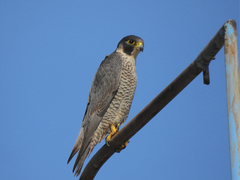Great cormorant
Phalacrocorax carbo
Aves Phalacrocorax carbo, commonly known as the Great Cormorant, is a large water bird recognized for its distinctive appearance and impressive adaptability to various aquatic environments. In the Comunidad Valenciana, it is sometimes referred to simply as cormorán.
This bird is predominantly black with a hefty body and a long neck. During the breeding season, adults develop a white patch on their thighs and their plumage becomes glossier. The Great Cormorant is known for its striking green eyes and long, hooked bill, which they use adeptly to catch fish, their primary diet.
- Habitat: The Great Cormorant is a versatile species that inhabits both inland freshwater and coastal marine habitats. In the Comunidad Valenciana, they are often seen in rivers, lakes, coastal lagoons, and along the seaside.
- Behavior: These birds are excellent divers and can dive underwater to significant depths in pursuit of prey. They are often spotted perched with wings outstretched, a behavior linked to drying their feathers. Unlike many other aquatic birds, cormorants lack waterproofing oils on their feathers, making them heavy and less buoyant when they dive.
- Nesting: The Great Cormorant typically builds nests in colonies, often in tree canopies or on rocky ledges. They use sticks and other available materials to create their nests. Breeding season in the Comunidad Valenciana can be an ideal period to observe these communal nesting habits.
- Local Significance: In the Comunidad Valenciana, the Great Cormorant is considered an integral part of the aquatic ecosystems. They play a role in controlling fish populations and are often observed by nature enthusiasts and bird watchers.
The Aves Phalacrocorax carbo is a species that exemplifies adaptability and has successfully thrived across various habitats, making it an intriguing subject for both scientific study and public observation in the region.







